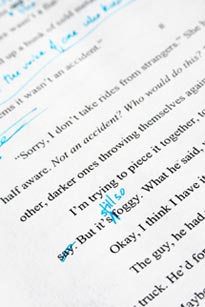In our personal or professional lives, there is no substitute for having excellent writing skills. However, just as important are editing skills. If you imagine creating a sculpture, writing gives the sculpture form. Editing, on the other hand, perfects it into its final form. Unlike sculpture though, writing and editing are two very different skills.
In finalizing any kind of written communication, here are five tips for being your own best editor:
1. Avoid “double duty.”
This means write first then edit. Don’t try to write and edit simultaneously. It sounds simple enough, but trying to do both is our most natural tendency. As any good writer knows, it takes focus and practice to just write, without correcting yourself or pondering if there is a more perfect word, a more perfect way to say something as you go. Doing double duty gets in the way of creative juices.
2. Let it sit.
Once you have a draft, take your eyes away from it for at least a few hours, preferably more time than that. Let it sit until your recall of what you wrote starts to wane just a bit – or more. Why? Because it will help you look at it again with fresh editorial eyes.
3. Pretend it is not yours.
This is probably the most difficult tip. We so easily have ownership of what we write and it is hard to let go of this. But the more you can pretend you are editing for someone else, say a client, the more objective you will be able to be as you approach the editing phase.
4. Use and re-use the “cut it in half” rule.
In the movie, A River Runs Through It, the father character read his son’s essay, then handed it back to him and said, “Cut it in half.” The son went away and did so, brought it back to his father, who said it again – “cut in half.” As your own editor, do this at least twice. Look back with a keen eye and ask yourself how each sentence could be made shorter, more streamlined, more to the essence.
5. Think active, not passive.
The “cut in half” rule is greatly helped by combing for every place active verbs are not used. The most common involves the use, or overuse of the word “is.” Challenge yourself to replace it with verbs that convey action as much as possible.
If you practice these five strategies, you will develop your editorial hat, and be on your way to making your writing the best it can be!

